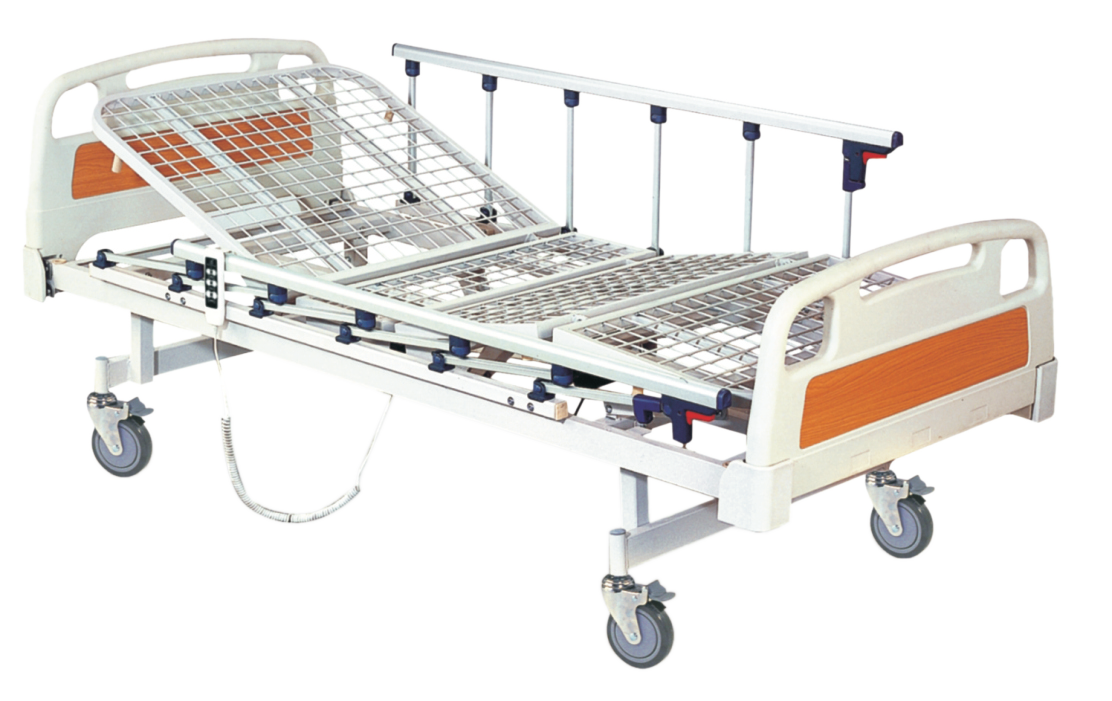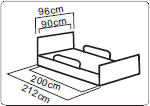
Hospital Bed
When you're looking for a hospital bed, it's important to make sure the models you're considering meet all your needs. Here at Contour Products, we carry a variety of different types of electric hospital beds that will meet the specific needs of your situation and make your recovery process much more comfortable.
 |
 |
 |
 |
 |
|---|
A hospital bed is a bed specifically designed for hospitalized patients or others in need of medical care. Hospital beds can be either manual or electric, and they are typically larger and more sturdy than a standard home bed. Manual hospital beds can be adjusted by hand, while electric ones use motors to adjust the height, head, and foot sections.
There are many different types of hospital beds available on the market, so it’s important to choose one that will best meet your needs. If you’re in the hospital for a short-term stay, for example, you may not need all the bells and whistles of a more expensive model. But if you’re looking for a long-term solution, you’ll want to make sure you get a bed that has all the features you need to be comfortable.
Some of the most important features to look for in a hospital bed include:
Adjustability: You’ll want a bed that can be easily adjusted to provide the most comfort possible. Electric beds offer the most adjustability, but they can also be quite expensive. Manual beds are more affordable, but they require someone else to help make adjustments.
Weight capacity: Make sure to choose a bed that can accommodate your weight. Most standard hospital beds have a weight limit of 250 pounds, but there are some heavy-duty models that can hold up to 1,000 pounds.
Safety features: Some hospital beds come with safety features like bed rails or built-in alarms. These can be helpful if you’re at risk for falling out of bed or wander off.
What is a Hospital Bed Mattress?
A hospital bed mattress is a mattress specifically designed for use in a hospital bed. Hospital bed mattresses are typically larger and more sturdy than a standard home mattress, and they often have special features that make them more comfortable for patients. Some of the most important features to look for in a hospital bed mattress include:
Firmness: Hospital bed mattresses are available in different levels of firmness, so you can choose one that’s right for you. If you’re not sure what level of firmness you need, your doctor or nurse can help you decide.
Pressure relief: Many hospital bed mattresses are designed to reduce pressure on your body, which can help prevent pain and improve blood circulation. Look for a mattress with built-in pressure relief or an air-filled design.
Temperature control: Some hospital bed mattresses come with built -in heating and cooling features. This can be helpful if you’re trying to regulate your body temperature or if you have hot flashes.
Washability: Many hospital bed mattresses are made from materials that can be easily washed. This is important because it helps prevent the spread of infection.
What is a Hospital Bed Rails?
Hospital bed rails are bars that attach to the sides of a hospital bed to provide support and safety for patients. Hospital bed rails can be either manual or automatic, and they are typically made from metal or plastic. Manual hospital bed rails must be lowered and raised by hand, while automatic ones use motors to do the work for you. Some models also come with built-in alarms that will sound if someone tries to lower the rails without permission. Hospital bed rails are an important safety feature, but they can also be quite dangerous if they’re not used properly. Make sure you understand how to use them before getting in or out of bed, and always follow your doctor’s or nurse’s instructions.
There are many reasons why you should use a hospital bed. One reason is that hospital beds can help improve your quality of sleep. If you have difficulty sleeping in a regular bed, a hospital bed may be just what you need to get a good night's sleep. Another reason to use a hospital bed is for pain relief. If you suffer from back pain, neck pain, or any other type of pain, using a hospital bed can help to relieve that pain. Hospital beds are also great for people who have difficulty getting in and out of regular beds. If you are recovering from an injury or surgery, using a hospital bed can help you to heal faster and more comfortably. Hospital beds offer many features that regular beds do not, such as adjustable heights and positions, which can help you to find the perfect position for healing. Finally, using a hospital bed can also help to reduce stress and anxiety levels. If you are feeling anxious or stressed, lying in a hospital bed can help you to feel more relaxed and calm.
Hospital beds come in a variety of shapes and sizes, each designed for specific patients and conditions. Some common types of hospital beds include:
-A standard hospital bed is the most basic type of bed, typically with just a mattress and frame.
-An adjustable hospital bed can be raised or lowered to accommodate the needs of the patient.
-A bariatric hospital bed is designed for obese patients, with a wider frame and heavier duty construction.
-A pediatric hospital bed is smaller in size to better fit children.
If you or a loved one are in need of a hospital bed, it is important to pick the right one. There are many different types of hospital beds, each with their own functions and features. Here is a guide to help you pick the right hospital bed for your needs. Hospital beds come in many different shapes and sizes. Some are designed for patients who need to be in an upright position, while others are meant for those who need to lie down. There are also beds that can be adjusted to fit the needs of both positions. The type of mattress on the bed is also important to consider. Some mattresses are designed to prevent pressure sores, while others are softer for added comfort. There are also memory foam mattresses that contour to the body for added support. When choosing a hospital bed, it is important to consider the needs of the patient. Some beds come with extra features like built-in TVs or massage functions. Others have special features for those who suffer from conditions like arthritis or diabetes. It is also important to think about the budget when picking a hospital bed. There are many different price points available, so be sure to find one that fits within your budget.
A hospital bed is a type of bed specially designed for hospitalized patients or others who need medical care. There are three main types of hospital beds: medical/surgical beds, critical care beds, and long-term care beds. Each type of hospital bed has different features and benefits that make them better suited for different types of patients and different stages of their illness or injury.
Medical/surgical beds are the most common type of hospital bed. They are typically used for patients who are recovering from surgery or other medical procedures, as well as those who need close monitoring and frequent nursing care. These beds have many features that make them comfortable and safe for patients, including adjustable head and foot sections, grab rails, and IV poles.
Critical care beds are designed for patients who require constant monitoring and intensive nursing care. These beds have all the features of medical/surgical beds, plus additional features that make them even more comfortable and safe for critically ill patients. Some of these features include built-in oxygen tanks, suction machines, and cardiac monitors.
Long-term care beds are designed for patients who need to be in the hospital for an extended period of time. These beds have many of the same features as medical/surgical beds, but they also have additional features that make them more comfortable for long-term use. Some of these features include pressure-relieving mattresses, built-in TV trays, and storage cabinets.